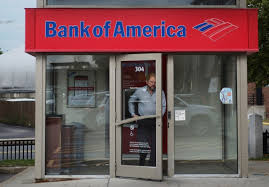Make Bank of America great again

IN THE skyscraper that is Bank of America’s New York headquarters, the chief executive, Brian Moynihan, looks relaxed. The bank has just announced record first-quarter earnings. Its return on equity is comfortably in double digits. Its share price has been on a roll. The revival of America’s second-largest bank, he avers, was inevitable. Any dark moments? None, except perhaps when America’s sovereign debt was downgraded in 2011 and all the country’s banks suffered. Early hints at the current prosperity? On his first day in the job, in 2010, he says. Vast losses from bad debt and litigation merely obscured billions of dollars in operating profits. “We just had to get rid of what was dragging us down.”
In fact, this renaissance was anything but predictable. Over little more than half a century Mr Moynihan’s two predecessors, Hugh McColl and Ken Lewis, had transformed the tiny North Carolina National Bank into an institution that could claim a business relationship with half of all American households. Any disruption along the way was dwarfed by the consequences of the final two acquisitions, Countrywide Financial, a subprime lender, and Merrill Lynch, an investment bank with underwriting, brokerage and trading arms. Both imploded during the financial crisis. Asked what made Mr Moynihan the right person to take over in the midst of the chaos, the acerbic Mr Lewis was reputed to have quipped: “He wanted the job.”
Over the next five years Bank of America lost $ 134bn on loans that were repaid late or not at all and related expenses, and spent a further $ 64bn on litigation. Headcount had peaked at 302,000 in 2009 after the Merrill purchase; it fell by 100,000 in a brutal series of redundancies. The number of branches was slashed from 6,100 in late 2008 to 4,500. For years, the pain seemed fruitless. As recently as February 2016, its shares traded at half their accounting value. Regulations that in effect outlawed acquisitions constrained its opportunities for growth. Investors had little faith in the worth of its assets, or indeed in its strategy.
The stockmarket has since become a believer. The bank’s shares now trade at 130% of accounting value. The threat of regulatory sanctions continues to hang over all financial institutions, but Bank of America has been replaced by Wells Fargo as a favoured target. And it has benefited from government policies in other ways. The recent cut in corporate taxes lowered its effective tax rate from 27% to 18%, accounting for a third of its increased profits. The wide variety of capital standards to which big banks must adhere gives a relative advantage to those that have lots of businesses, and can thus arrange their affairs most efficiently. The crisis-era bail-outs sent the message that the government regarded the largest banks as too big to fail. Deposits have since flooded in (see chart), even though interest rates have been nugatory, keeping funding costs down. And the rules intended to avert future bank failures have helped big banks see off competition from smaller ones, since they can spread compliance costs over a larger base.
Mr Moynihan is now hacking away at anything not directly related to servicing Bank of America clients. He has got rid of stakes in Santander, BlackRock, China Construction Bank and Banco Itaú; credit-card businesses in Britain, Canada, Ireland and Spain; and a slew of private-equity investments. He has kept hubs in London and Hong Kong for trading and investment banking, which act as a conduit between foreign clients and America, and American clients and the world. But wealth management, once offered in 35 countries, is now offered in just one—America.
Internal restructuring has been unrelenting. The bank claims to have moved away from lucrative but risky activities such as subprime lending for cars, cards and homes. When Mr Moynihan took over the top job, 23 kinds of current accounts were offered. That has been cut to three. The number of people visiting Bank of America branches has declined from a peak of 1m weekly a couple of years ago to 850,000, even as the volume of transactions has increased. A quarter of all deposits are now done using a cheque-photographing feature on smartphones.
Finally, however, Mr Moynihan can return to thoughts of expansion. The bank has announced that it will start to open new branches once more. There will be fewer teller windows and more side-offices where staff can sell investments and loans. It is also trying to create a bridge between its retail branches and its wealth-management and investment-banking activities. It wants to drum up business from midsized companies that would prefer to issue securities through the investment bank, rather than take a loan, and from individuals who would like investment options alongside their bank accounts. It has built a new electronic platform, Merrill Edge. That should help it compete with Fidelity and Charles Schwab, and provide new clients for Merrill’s brokers, now rebranded financial advisers.
None of this is all that dramatic. But that is intentional. After the trauma of the financial crisis, any abrupt or daring change of direction by a big American bank would probably be blocked by regulators. For now and some time to come, the twin aims will be to keep improving operational efficiency and avoid disaster. Mr Moynihan has done well enough at both that, when the time comes to replace him, there should be plenty of willing candidates.
This article appeared in the Finance and economics section of the print edition under the headline “Dollars and sense”